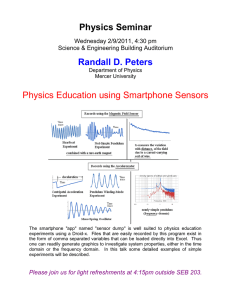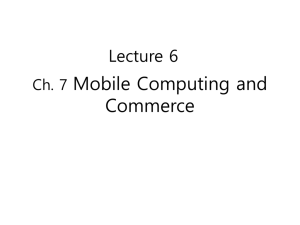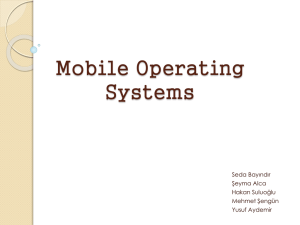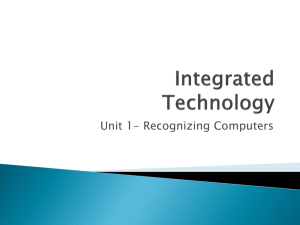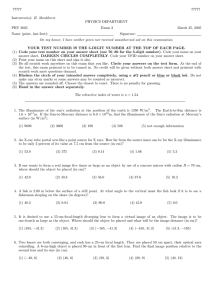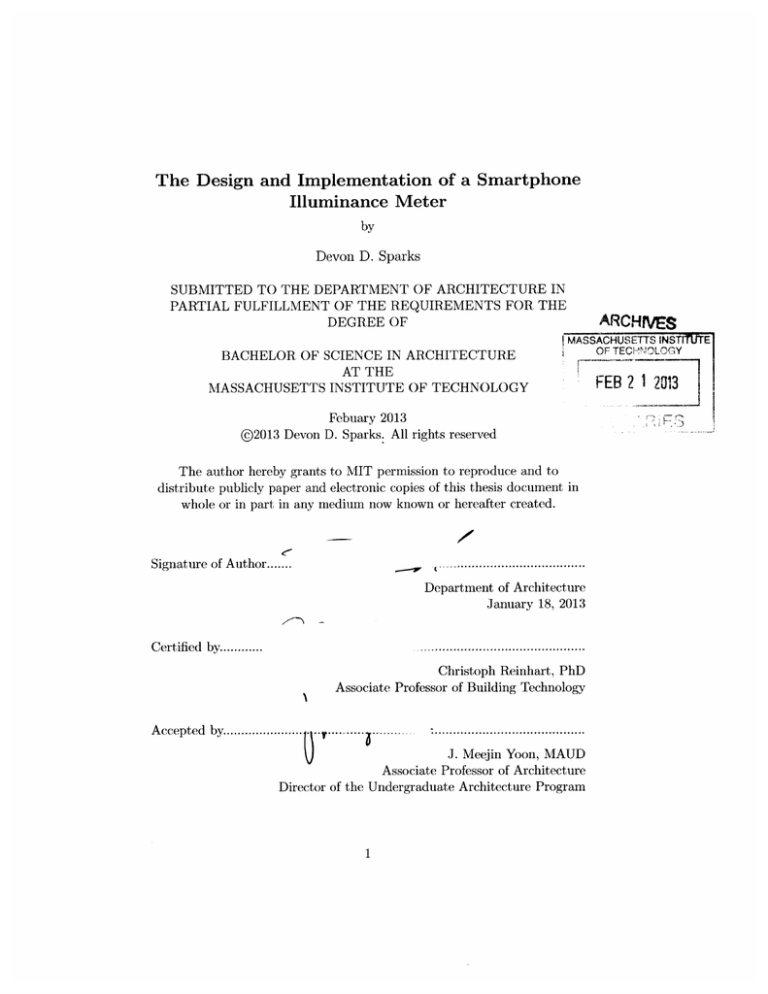
The Design and Implementation of a Smartphone
Illuminance Meter
by
Devon D. Sparks
SUBMITTED TO THE DEPARTMENT OF ARCHITECTURE IN
PARTIAL FULFILLMENT OF THE REQUIREMENTS FOR, THE
DEGREE OF
ARCHNES
MASSACHUSETTS INSTr UTE
BACHELOR OF SCIENCE IN ARCHITECTURE
AT THE
MASSACHUSETTS INSTITUTE OF TECHNOLOGY
@2013
Febuary 2013
Devon D. Sparks. All rights reserved
The author hereby grants to MIT permission to reproduce and to
distribute publicly paper and electronic copies of this thesis document in
whole or in part in any medium now known or hereafter created.
1-0
S-
Signature of Author ...
Department of Architecture
January 18, 2013
Certified by............
Christoph Reinhart, PhD
Associate Professor of Building Technology
Accepted by...................
.T
..
J. Meejin Yoon, MAUD
Associate Professor of Architecture
Director of the Undergraduate Architecture Program
1
OF TEC
1 201
FEB 21 2313
The Design and Implementation of a Smartphone
Illuminance Meter
by
Devon D. Sparks
Submitted to the Department of Architecture on January 18th, 2013
in partial fulfillment of the requirements of the Degree of
Bachelor of Science in Architecture
Abstract
The proliferation of consumer smartphones has offered new opportunities
for environmental sensing and mobile computation. Recent smartphone
models - equipped with GPS trackers, accelerometers, megapixel cameras
and rich software stacks - offer the possibility of emulating specialized
tools completely in software. This paper documents recent efforts to build
a robust, smartphone-based illuminance meter application, and describes
its prototype implementation. Though hardware and software constraints
prevent the complete development of such a prototype, its use and
potential are demonstrated.
Thesis Supervisor: Christoph Reinhart
Title: Associate Professor of Building Technology
2
The Design and Implementation of a
Smartphone Illuminance Meter
Devon D. Sparks
January 2013
1
Introduction
Rapid advances in consumer electronics and advertising have transformed
the mobile device market. Single-function mobile phones of the early 1990s
were overtaken by "feature phones", only to be usurped by the powerful,
touchscreen smartphones of the last few years. Now standard issue for 74%
of Americans aged 24-35 [15], smartphones have been ceaselesly recast as
tour guides, news readers, desktop calculators, event planners, and sound
mixers. When one machine has the ability become most others with the
swipe of a finger, there are two practical issues to consider: what is the
upper bound on a smartphone's ability to replace specialized tools, and how
might this be changed? This paper explores both questions in the domain
of building science, using a smartphone-based illuminance meter as its test
application. Its conclusions are straightforward: that despite their power,
existing smartphones are not yet fit-for-purpose as digital light meters, and
that some of their failings can be fixed. It examines the limitations of current
smartphone software stacks in supporting accurate illuminance calculation,
and speculates on the potential use of smartphones as tools for teaching
building science and architectural daylighting.
2
Review of Existing Smartphone Light Meters
The promise of smartphones as tools for environmental monitoring has been
widely published [9] [12]. Illuminance meter applications for two leading
smartphone software stacks - Google's Android and Apple's iOS - make
3
Developer
Developer
Platform
Rating
Name
1-Ap Light Sensor
Light meter
Lightmeter
MobiLux
Light Lux Meter
LuxMobile
Light Meter
Lux Meter
Light Meter
LuxMeter
Check The Light
LightMeter
1-Ap
Manas Gajare
MikLab
Tech.Music-Bee
Herbert Mhlburger
NECTECH
Borce Trajkovski
oxdb.net
Roger Yang
App Manufactory
Stichting
whitegoods
Android
Android
Android
Android
Android
Android
Android
Android
Android
iOS
iOS
iOS
2.8/5.0, 49 Reviews
1.0/5.0, 3 Reviews
2.7/5.0, 76 Reviews
2.6/5.0, 86 Reviews
3.1/5.0, 27 Reviews
3.1/5.0, 17 Reviews
3.4/5.0, 341 Reviews
2.5/5.0, 158 Reviews
3.2/5.0, 29 Reviews
4 Stars, 1 Review
1 Star, 5 Reviews
3 Stars, 12 Reviews
Name
Platform
Rating
Table 1: Ratings of Reviewed Sinartphone Light Meters, October 2012
use of a smartphone's internal light sensor to estimate scene illuminance.
User reviews are consistently poor (see Table 1), due in large part to the
limitations of the phone's ambient light sensor. Though a photodiode may
be an appropriate tool for adjusting an LCD backlight, its sensitivity is
too gross for accurate illuminance calculation. Of 12 reviewed illuminace
meters available in Google Play and Apple App Store, all depend on the
limited accuracy of the phone's ambient light sensor. Fortunately, the large
number of disappointed reviews demonstrates the clear interest in a more
robust smartphone light meter, and the release of increasingly sophisticated
software stacks lays fertile ground for its development.
3
Proposal for a New Light Meter
A proper smartphone light meter should embody the basic qualities of a
specialized meter (small size, easy of use), but leverage the processing power
and network connectivity of mobile phones. To accurately measure scene
illuminance, it must use a fine sensor, recover spot luminance from encoded
pixel values, and give results in reasonable time for side- and toplit spaces.
These requirements demand that illuminance calculation be converted into a
multi-stage pipeline: capture, merging, and calculation (see Figure 1). Each
module, along with its prototype implementation built on a Samsung Galaxy
4
300lx
Capture
Merge
Calculate
Figure 1: Illuminance Calculation Workflow
Nexus running Android 4.1, will be described in the following sections.
3.1
The Capture Pipeline
To accurately estimate scene illuminance, a smartphone light meter must
have a field of view large enough to account for top and side lighting. As
most smartphone cameras (including the Galaxy Nexus) have a relatively
narrow field of view (50-60 degrees), multiple images must be captured to
allow for panorama generation. To guide the image capture process, a new
interface is needed.
In the prototype implementation, the user is presented with a "mass and
spring" simulation, controlled by the phone's orientation sensors and a
software-based Verlet path integrator. As the phone shifts orientation, a
virtual mass stretches away from the screen's center proportional to the tilt
(see Figure 2). Once in contact with the active on-screen target (shown as a
small red circle in the-prototype interface), the phone's front-facing camera
captures several lossy (i.e. JPEG encoded) images of the current scene ideally with varying exposure times - and writes them to internal storage
for later processing. The targets are positioned to maximize the chance of
feature matching between image pairs. As the simulation is rotationally invariant, it is assumed the user remains stationary throughout the capture
exercise.
The intent behind a mass-and-spring simulation is twofold: first, to force the
user to slow his movement, and focus his attention, so that crisp scene fragments can be captured; and second, to reduce his perception of elapsed time
while background threads complete image analysis. If illuminance calculations must be computationally intensive, the best an application designer
can do is make the wait an imperceptible one.
5
(a) target 1
(b) target 2
(e) target 7
(f) target 8
(d target 4
(g) target 11
(h) target 16
Figure 2: Image Capture Interface Prototype
6
3.2
The Merging Pipeline
Once captured, the application aligns images pairwise, storing homographies
calculated using the algorithms of BoofCV [7], a pure-Java implementation
of OpenCV [5] (see Figure 3). It then attempts to collapse these images into
a single mosaic with a 90'effective field of view. These images become the
input for the next pipeline stage, which implements fisheye projection using
a cubic environment mapper [11].
Generating large image mosaics on a small phone is not easy. It is computationally expensive (both in time and space), especially on a machine with a
16-24MB memory limit per application'. Fortunately, experiments with the
prototype image stitching module were largely successful, generating complete, 90 'field of view planar images in 20-30 seconds each in more than 75%
of trials.
However, there are strong caveats to this approach. Fundamental properties of the workflow that make it a poor match for smartphones. Successful
feature matching of the overhead scene required 8-12 source images, pairwise homography calculation, and repeated reading from external storage to
avoid Android's internal memory constraints. Homography calculation depends on the success of feature correspondence between overlapping images,
a challenge if the overhead scene has few distinguishing features. In order
to generate a full 180'fisheye perspective, four additional mosaics must be
generated, each representing the upper half of the user's view in each of the
cardinal directions. This says nothing of high dynamic range (HDR) image
generation or response curve recovery, described in the next section.
One research-grade mobile software stack has managed to mitigate some
of these challenges [8], at the cost of specific smartphone hardware, a custom operating system installation, and modified firmware. Other efforts to
perform multi-directional HDR panorama generation have either offloaded
the feature correspondence calculations to back-end servers, or used one of
the two image registration routines outlined in Reinhard, Ward et. al. [14,
p. 122]. The faster of these routines - the mean threshold bitmap alignment
routine - is unsuited for images taken at different view angles, making it a
See the section Displaying Bitmaps Efficiently of the Android Training Manual for
details: http://developer.android.com/training/displaying-bitmaps/index.html. There is
some discussion that this hard limit can be overcome through use of Google's Native Development Kit (NDK), though this option was not pursued here; tight resource constraints
are not the only count against a smartphone-based illuminance meter.
7
(b) Tou-Central Mosaic
(a) Central Image
(d) Right-Central Mosaic
(c) Left-Central Mosaic
(e) Composite Mosaic
Figure 3: Sample Mosaic Generation
8
poor match for smartphone deployment.
Perhaps the greatest threat to accurate illuminance calculation using image
mosaic techniques is the introduction of object distortion during merging.
In Figure 3e, for example, small discrepancies in feature correspondence between successive image sets created an erroneous fragment of the author's
head in the lower-left corner of the image. These erroneous fragments (a
consequence of the stochastic nature of feature matching routines) are troublesome for illuminance calculations when they under- or overrepresent the
size of light sources. This problem can be overcome (at additional cost and
loss of convenience) with the use of an external fisheye lens.
3.3
The Calculation Pipeline
Under the assumption that an HDR image mosaic can be generated from
scene fragments, implementation of a luminance integral - the central calculation in a smartphone light meter - is trivial. Given a smartphone camera's
unique response curve, integration involves a linear transformation, lookup,
and Reimann sum for all pixels in the input image. In the prototype implementation, luminance integration on sample, low dynamic range images
never took more than a few seconds.
While outputting a single illuminance value would fulfill all the requirements
of a fit-for-purpose light meter, the high resolution display and network connectivity of smartphones offers new opportunities. With user permission,
illuminance calculations could be uploaded to an online database, capable
of archiving HDR images and GPS coordinates along with a qualitative description of the scene. Such an archive could become the basis of further
work in the human factors associated with architectural daylighting, and
improve student intuition of lighting fundamentals. Such collaborative tools
have been deployed in other fields (as in the SoundAroundYou.com environmental audio archive from the University of Salford), and there's little reason
to think their success could not be replicated by daylighting practioners and
students.
4
Hardware Limitations of Smartphones
Methods for computing scene illuminance using mass-market digital cameras are well known [16]. Though a smartphone camera has no mechan9
ically adjustable aperture, its sensor array can transform the number of
photons impinging each sensor into a proportional voltage, perceived as a
pixel brightness in the final image. Many smartphone cameras now support
multi-megapixel sensors, but remain bound to software APIs that encode
24-bit image formats. One byte for each red, green and blue color channel
allows for 16.7 million colors per pixel, but only 256 values per channel. In
2
5
scenes with some combination of sunlighting (10 cd/m ) and artificial light2
2
ing (10 cd/m ), one byte per channel per pixel can never represent the full
dynamic range in a single image; most snapshots will be under- or overexposed. However, capturing multiple images of a static scene with varying
exposure times provides an array of RGB values for each pixel, at least one
of which will be properly exposed. By choosing proper exposures on a pixelby-pixel basis, an HDR image can be generated that removes the limitations
of standard, low dynamic range (LDR.) imaging.
If accurately captured, each pixel in a source image can then undergo a
change of basis from RGB into the CIE XYZ color space [13], where the
CIE Y value closely matches spectral luminous efficiency of the human eye
for phototopic vision [1]:
X
Y
Z
0.4124
0.2126
0.0193
0.3576
0.7152
0.1192
0.1805
0.0722
0.9505
R
1
G
B _
Assuming an ideal, linear image sensor, each spot luminance can be normalized by dividing out its exposure time [14, p. 117]. As a practical matter,
most digital cameras do not have a linear response; manufacturers often introduce gamma correction into their image processing pipelines in order to
generate more pleasing images for monitors and print. Restoring this linear mapping requires recovery of the camera's unique response curve, called
the Opto-Electronic Conversion Function (OECF), and described in International Standard ISO 14524 [2]. Thankfully, once captured and stored, the
camera response curve may can be used for subsequent exposures.
One popular algorithm for recovering this mapping, due to Debevec and
Malik [10], leverages the fact that by capturing different exposures of a
static scene, "one is effectively sampling the camera response function at
each pixel." [14, p. 137] When the exposure values are plotted against each
pixel value, Debevec and Malik use linear optimization to find a smooth
curve that minimizes the mean-squared error over each of the three red,
green, and blue color channels. If the camera hardware performs automatic
and proprietary on-chip image processing, linear optimization on one or
10
more channels may fail, and an accurate response curve will not be found.
Response recovery on a Samsung Galaxy Nexus, a Google-endorsed smartphone running Android 4.1, proved unsuccessful for just this reason. Anywhere Software's Photosphere failed to produce an accurate response curve
on all of seven independent trials, each using seven input images taken with
Android's built-in camera application (one for each of the four available
capture modes, and three additional images using the built-in area metering
feature). Few image sets converged at all, and those that did gave polynomials of the first or second degree - less accurate than a generic sRGB
response curve. Response recovery on images taken with the manual exposure settings of a Canon EOS Rebel T3, in contrast, were consistently
successful, implying that the lack of manual exposure control and on-chip
image processing of the Android-based smartphone was stunting response
recovery.
Existing Android camera parameters - like area metering, and exposure
compensation - are not appropriate substitutes for manual exposure: the
former for its inability to reliably alter the automatic exposure settings of the
camera firmware, and the latter for its application as a post-processing step,
after pixel values have been encoded. Apple's iOS camera APIs, which provide similar features, have similar shortcomings. Use of a generic response
curve is also ill-fated, as Reinhard, Ward et. al. note [14, p. 136]:
"Assuming an sRGB response curve is unwise, because most
makers boost image contrast beyond the standard sRGB gamma
to produce a livelier image. There is often some modification as
well at the ends of the curves, to provide software highlights and
reduce noise visibility in shadows."
It is a surprising fact that, at the time of writing, neither Google Android
nor Apple's iOS provide official support for manual exposure control - requisite for HDR generation, response curve recovery, and accurate illuminance
calculation. This restriction is well documented for the Android platform in
Google Android Issue #5692 [3], and on iOS in the AVCaptureDevice Class
Reference [4]. Given that illuminance calculation with mass-market digital
cameras is well understood [16], it is clear this restriction affects smartphone
camera hardware and software stacks specifically.
11
(a) parameter: 0.01
(b) parameter: 0.02
(c) parameter: 0.05
(d) parameter: 1.0
(e) parameter: 10.0
(f) parameter: 100.0
Figure 4: Apple iOS Manual Exposure API Results
5
Smartphone Camera API Restrictions
As of late 2012, the iOS and Android software stacks provide no official support for manual exposure control for smartphone cameras. Beginning with
iOS 6.0, however, HDR image generation is possible within Apple's builtin camera application. A review of the A VCaptureDevice class headers in
iOS 6.0 reveals several private method calls for manual exposure, including
one setExposureDuration: that takes a single C structure as an argument. Unfortunately, the class headers can only provide information on
argument types required by this method, and can say nothing about their
meaning. Calling the setManualExposureSupportEnabled: method of
an AVCaptureDevice with YES enables the new exposure mode. Manual
exposure on an iPhone camera can then be enabled by passing the new mode
flag (3) to the AVCaptureDevice.
Brute-force experimentation with the structure arguments to setExposureDuration: produced the image set in Figure 4 on an iPhone 4 with iOS
6.0, suggesting that a more flexible (if currently undocumented) manual
exposure camera API may exist for Apple iOS devices.
As this paper went to print, Google Inc. released Android OS 4.2, which
includes a new HDR scene mode for the built-in camera application. This
theoretically provides the same HDR functionality available in iOS 6.0, but
requires modifications to the system kernel and camera drivers. The HDR
scene mode only supports the Google Nexus 4 hardware at the time of
12
writing, with the Android 4.2 APIs still unable to provide application-level
manual exposure or white balance controls.
6
Discussion
The inability to control the underlying camera hardware directly from the
iOS or Android software stack regrettably stall efforts to develop a light
meter application suitable for design science teaching. This is both a limitation of existing software stacks and hardware specifications. The welldocumented use of mass-market digital cameras and PC-based image analysis workflows implies that, with some potential hardware and software modifications, smartphones could emulate the behavior of existing illuminance
meters.
The hardware limitations of smartphone camera modules may be the greatest obstacle to development. Such modules are optimized to minimize space,
power and manufacturing requirements, maximize on-chip image processing,
and produce pleasing images in low-light conditions using short exposure
times. Most modules have integrated lens, increasing the chance of lens
flaring. These specifications are entirely antithetical to the needs of camerabased illuminance calculation, including: repeatable, low-noise data (which
implies a low, fixed sensitivity); manual white balance control; a low-flare
lens system; an unaltered tone curve; RAW data capture for photometry calculations; and a mechanically adjustable aperture. More damning is the lack
of metadata documenting transformations applied to each image by the camera module. With no record of image processing performed on input data,
and no means to control the module's processing pipeline, the relationship
between the raw sensor data and output pixel values is unpredictable.
This does not rule out the possibility of a smartphone-supported light meter in the future. In the worst case, the motivated user could modify his
smartphone's firmware, install a basic Linux installation on its drive, buy
an inexpensive, USB-enabled camera with a fisheye lens, and emulate the
HDR generation and illuminance calculation workflow normally performed
on workstations. While technically possible, this approach is hardly practical. Smartphone applications appeal because they are configuration-free,
instantly available, and device agnostic. An application that requires an
external lens, top-of-the-line hardware, and two-minute wait time fails on
all three counts, and has little to offer relative to even the most inexpen-
13
sive specialized meters. If development of a robust smartphone light meters
proves to be an unreasonable challenge, a specialized (but inexpensive and
open source) meter could be built using off-the-shelf components (e.g. a
Raspberry Pi [6] system-on-a-chip, a USB-enabled camera, and an inexpensive fisheye lens). This would offer a viable alternative to commercial light
meters for students of architecture and engineering, and be open for exploration and modification in its own right. The author intends to explore this
approach in the coming months.
If mobile software vendors (particularly Google and Apple) introduce new
camera APIs that support manual exposure control, flexible, developer-level
HDR generation may be viable. Some technical cleverness may be required
to circumvent application memory limits, but this is a surmountable challenge. Panoramic stitching of wide-angle scenes - important in spaces with
considerable side-lighting - will remain technically feasible, if unwieldy. API
changes providing native support for panorama generation may improve this
lot, though it remains to be seen whether it will be enough to offset the wait
time required between image capture and illuminance calculation. Though
it may be a slight kludge, the use of an external, mountable fisheye lens
(available for less than the price of some lunches) avoids many of the problems outlined in previous sections. If the goal of a smartphone-based light
meter is to develop intuition, and offer first-order accuracy of calculation, it
is a boon to avoid computionally expensive image stitching and use a basic
lens. Then users, developers, and researchers can focus more on the practical implications of calculation and less of the technical wizardry that made
it possible.
References
[1] ITU-R Recommendation BT. 709, Basic Parameter Values for the
HDTV Standard for the Studio and for InternationalProgramme Exchange. ITU (International Telecommunications Union), Geneva, 1990.
[2] ISO 14524. International Organization for Standardization, 1999.
http://code.google.com/p/android/issues/
[3] Android issue #5692.
10/10/2012.
2009.
detail?id=5692,
[4] Avcapturedevice
class
reference.
https://developer.apple.
com/library/mac/documentation/AVFoundation/Reference/
14
AVCaptureDeviceClass/AVCaptureDeviceClass.pdf,
2012.
10/14/2012.
[5] Opencv wiki. http: //opencv. willowgarage .com, 2012. 10/12/2012.
an arm gnu/linux box for $25. take a byte!
[6] Raspberry pi
//www. raspberrypi. org, 2012. 12/16/2012.
http:
[7] P. Abeles. Boofcv. http: //boof cv. org, 2012. 6/15/2012.
[8] A. Adams, E.-V. Talvala, S. H. Park, D. E. Jacobs, B. Ajdin,
N. Gelfand, J. Dolson, D. Vaquero, J. Baek, M. Tico, H. P. A. Lensch,
W. Matusik, K. Pulli, M. Horowitz, and M. Levoy. The frankencamera:
an experimental platform for computational photography. A CM Trans.
Graph., 29(4):29:1-29:12, July 2010.
[9] S. Aram, A. Troiano, and E. Pasero. Environment sensing using smartphone. In Sensors Applications Symposium (SAS), 2012 IEEE, pages
1-4. IEEE, 2012.
[10] P. E. Debevec and J. Malik. Recovering high dynamic range radiance
maps from photographs. SIGGRAPH 97, August 1997.
[11] N. Greene. Environment mapping and other applications of world projections. Computer Graphics and Applications, IEEE, 6(11):21 -29,
nov. 1986.
[12] N. Lane, E. Miluzzo, H. Lu, D. Peebles, T. Choudhury, and A. Campbell. A survey of mobile phone sensing. Communications Magazine,
IEEE, 48(9):140 -150, September 2010.
[13] C. Poynton. A guided tour of color space. In SMPTE Advanced Television and Electronic Imaging Conference, pages 167-180, 1995.
[14] E. Reinhard, G. Ward, S. Pattanaik, and P. Debevec. High Dynamic
Range Imaging: Acquisition, Display, and Image-Based Lighting (The
Morgan Kaufmann Series in Computer Graphics). Morgan Kaufmann
Publishers Inc., San Francisco, CA, USA, 2005.
[15] N. M. Resarch. Young adults and teens lead growth among smartphone
owners, September 2012.
[16] D. Wiler and H. Gabele. The usage of digital cameras as illuminance
meters. Electronic Imaging Conference, 2007.
15

